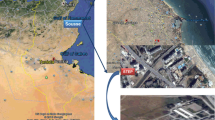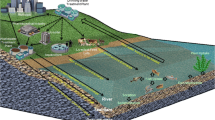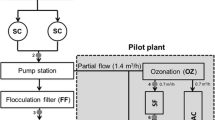Abstract
The occurrence and behavior of endocrine disrupting chemicals (EDCs) in sewage treatment plants (STPs), especially estrogens and phenols, have been closely concerned in previous studies. However, the systematical researches about progestogens and androgens were scarce in STPs adopting different treatment technologies. This work investigated the occurrence, removal, and fate of one progestogen, three androgens, four estrogens, and six phenols in six STPs around Dianchi Lake in China, where the influents, effluents of primary treatment, secondary treatment, and advanced treatment, as well as excess sludge samples, were analyzed. All of the above EDCs were detected out in influents of the six STPs. Bisphenol A, nonylphenol-mono-ethoxylate, and nonylphenol-diethoxylate were the dominant EDCs detected in those influent samples with the concentrations that varied from 637.6 to 1,684.0 ng/L, 633.8 to 1,540.0 ng/L, and 648.7 to 2,246.0 ng/L, respectively; E1 and dihydrotestosterone were the major steroids with the mean concentration of 126.8 and 277.4 ng/L. For effluents and sludges, phenols showed higher concentration (366.8–1,233.0 ng/L and 1,478.1–6,948.9 ng/g dry weight (dw)) and detection rate (100 %). The total removal rates were more than 80 % for most compounds in wastewater treatment processes, and high removal efficiency (86–100 %) was found for androgens and progestogens compared with estrogens (75–92 %) and phenols (62–85 %). The secondary treatment processes play significant roles on degrading EDCs, whereas the primary sedimentation has little effects. The treatment capacity of anoxic-anaerobic-anoxic membrane bioreactor and anaerobic/anoxic/oxic technologies was superior to the conventional oxidation ditch in the degradation of EDCs. The advanced treatment process, two units of filter (D-type or V-type), and ultraviolet disinfection were adopted and presented effective to remove these compounds. According to fate analysis, it was obvious that biological degradation was the main pathway on the removal of EDCs in STPs compared with adsorption. Risk quotients were calculated to assess ecological risks of those EDCs. Risk quotients of 54 and 61 % were more than 1 in effluents and sludges, respectively, showing potential hazard of effluents and sludges to the environment.










Similar content being viewed by others
References
Andersen H, Siegrist H (2003) Fate of estrogens in a municipal sewage treatment plant. Environ Sci Technol 37(18):4021–4026
Arditsoglou A, Voutsa D (2008) Determination of phenolic and steroid endocrine disrupting compounds in environmental matrices. Environ Sci Pollut Res 15(3):228–236
Braga O, Smythe GA, Schafer Feitz AJ (2005) Fate of steroid estrogens in Australian inland and coastal wastewater treatment plants. Environ Sci Technol 39:3351–3358
Caldwell DJ, Mastrocco F, Anderson PD, Länge R, Sumpter JP (2012) Predicted-no-effect concentrations for the steroid estrogens estrone, 17beta-estradiol, estriol, and 17alpha-ethinylestradiol. Environ Toxicol Chem 31(6):1396–1406
Chang H, Wu S, Hu J, Asami M, Kunikane S (2008) Trace analysis of androgens and progestogens in environmental waters by ultra-performance liquid chromatography-electrospray tandem mass spectrometry. J Chromatogr A 1195(1–2):44–51
Chang H, Wan Y, Wu SM, Fan ZL, Hu JY (2011) Occurrence of androgens and progestogens in wastewater treatment plants and receiving river waters: comparison to estrogens. Water Res 45(2):732–740
Clara M, Kreuzinger N, Strenn B, Gans O, Kroiss H (2005) The solids retention time: a suitable design parameter to evaluate the capacity of wastewater treatment plants to remove micropollutants. Water Res 39(1):97–106
Clara M, Scharf S, Scheffknecht C, Gans O (2007) Occurrence of selected surfactants in untreated and treated sewage. Water Res 41:4339–4348
Duong CN, Ra JS, Cho J, Kim SD, Choi HK, Park JH, Kim KW, Inam E, Kim SD (2010) Estrogenic chemicals and estrogenicity in river waters of South Korea and seven Asian countries. Chemosphere 78(3):286–293
Estrada-Arriaga EB, Mijaylova PN (2011) Influence of operational parameters (sludge retention time and hydraulic residence time) on the removal of estrogens by membrane bioreactor. Environ Sci Pollut Res 18(7):1121–1128
Fan ZL, Wu SM, Chang H, Hu JY (2011) Behaviors of glucocorticoids, androgens and progestogens in a municipal sewage treatment plant: comparison to estrogens. Environ Sci Technol 45(7):2725–2733
Fenner K, Kooijman C, Scheringer M, Hungerbühler K (2002) Including transformation products into the risk assessment for chemicals: the case of nonylphenol ethoxylate usage in Switzerland. Environ Sci Technol 36:1147–1154
Fernandez MP, Ikonomou MG, Buchanan I (2007) An assessment of estrogenic organic contaminants in Canadian wastewaters. Sci Total Environ 373(1):250–269
Fine DD, Breidenbach GP, Price TL, Hutchins SR (2003) Quantitation of estrogens in ground water and swine lagoon samples using solid-phase extraction, pentafluorobenzyl/trimethylsilyl derivatizations and gas chromatography-negative ion chemical ionization tandem mass spectrometry. J Chromatogr A 1017:167–185
Harries JE, Sheahan DA, Jobling S, Matthiessen P, Neall P (1997) Estrogenic activity in five United Kingdom rivers detected by measurement of vitellogenesis in caged male trout. Environ Toxicol Chem 16(3):534–542
Heidler J, Heidler RU (2007) Mass balance assessment of triclosan removal during conventional sewage treatment. Chemosphere 66(2):362–369
Huang B, Pan XJ, Wan X, Liu JL, Zhao SM, Hu P, Li FR (2011) Simultaneous determination of steroid environmental endocrine disrupting chemicals in water by solid phase extraction-derivatization-gas chromatography-mass spectrometry. Chin J Anal Chem 39(4):449–454
Huang B, Wang B, Ren D, Jin W, Liu JL, Peng JH, Pan XJ (2013) Occurrence, removal and bioaccumulation of steroid estrogens in Dianchi Lake catchment, China. Environ Int 59:262–273
Jin W, Huang B, Wang B, Wang DW, Zhao SM, Pan XJ (2013) Simultaneous determination of androgens and progestogen in surface water and sediment by gas chromatography-mass spectrometry. Chin J Anal Chem 41(2):205–209
Johnson AC, Sumpter J (2001) Removal of endocrine-disrupting chemicals in activated sludge treatment works. Environ Sci Technol 35:4697–4703
Johnson AC, Aerni HR, Gerritsen A, Gibert M, Giger W, Hylland K, Jürgens M, Nakari T, Pickering A, Suter MJ-F, Svenson A, Wettstein FE (2005) Comparing steroid estrogen, and nonylphenol content across arange of European sewage plants with different treatment and management practices. Water Res 39:47–58
Joss A, Andersen H, Ternes T, Richle PR, Siegrist H (2004) Removal of estrogens in municipal wastewater treatment under aerobic and anaerobic conditions: consequences for plant optimization. Environ Sci Technol 38:3047–3055
Karickhoff SW (1981) Semi-empirical estimation of sorption of hydrophobic pollutants on natural sediments and soils. Chemosphere 10(8):833–846
Kim SD, Cho J, Kim IS, Vanderford BJ, Snyder SA (2007) Occurrence and removal of pharmaceuticals and endocrine disruptors in South Korean surface, drinking, and waste waters. Water Res 41:1013–1021
Koh YK, Chiu TY, Boobis AR, Scrimshaw MD, Bagnall JP, Soares A, Pollard S, Cartmell E, Lester JN (2009) Influence of operating parameters on the biodegradation of steroid estrogens and nonylphenolic compounds during biological wastewater treatment processes. Environ Sci Technol 43(17):6646–6654
Kolpin DW, Furlong ET, Meyer MT, Thurman EM, Zaugg SD, Barber LB, Buxton HT (2002) Pharmaceuticals, hormones, and other organic wastewater contaminants in U.S. streams, 1999-2000: a national reconnaissance. Environ Sci Technol 36:1202–1211
Legler J, Zeinstra LM, Schuitemaker F, Lanser PH, Bogerd J, Brouwer A, DickVethaak A, Voogt PD, Murk AJ, van der Burg B (2002) Comparison of in vivo and in vitro reporter gene assays for short-term screening of estrogenic activity. Environ Sci Technol 36:4410–4415
Lin BL, Tokai A, Nakanishi J (2005) Approaches for establishing predicted-no-effect concentrations for population-level ecological risk assessment in the context of chemical substances management. Environ Sci Technol 39:4833–4840
Liu ZH, Kanjo Y, Mizutani S (2009a) Removal mechanisms for endocrine disrupting compounds (EDCs) in wastewater treatment-physical means, biodegradation, and chemical advanced oxidation: a review. Sci Total Environ 407(2):731–748
Liu ZH, Kanjo Y, Mizutani S (2009b) Urinary excretion rates of natural estrogens and androgens from humans, and their occurrence and fate in the environment: a review. Sci Total Environ 407(18):4975–4985
Liu JL, Wang RM, Huang B, Lin C, Wang Y, Pan XJ (2011) Distribution and bioaccumulation of steroidal and phenolic endocrine disrupting chemicals in wild fish species from Dianchi Lake, China. Environ Pollut 159(10):2815–2822
Liu JL, Wang RM, Huang B, Lin C, Zhou JL, Pan XJ (2012a) Biological effects and bioaccumulation of steroidal and phenolic endocrine disrupting chemicals in high-back crucian carp exposed to wastewater treatment plant effluents. Environ Pollut 162:325–331
Liu S, Ying GG, Zhao JL, Zhou LJ, Yang B, Chen ZF, Lai HJ (2012b) Occurrence and fate of androgens, estrogens, glucocorticoids and progestagens in two different types of municipal wastewater treatment plants. J Environ Monit 14:482–491
Loos R, Hanke G, Umlauf G, Eisenreich SJ (2007) LC-MS-MS analysis and occurrence of octyl- and nonylphenol, their ethoxylates and their carboxylates in Belgian and Italian textile industry, waste water treatment plant effluents and surface waters. Chemosphere 66(4):690–699
Mills LJ, Chichester C (2005) Review of evidence: are endocrine-disrupting chemicals in the aquatic environment impacting fish populations? Sci Total Environ 343:1–34
Nakada N, Tanishima T, Shinohara H, Kiri K, Takada H (2006) Pharmaceutical chemicals and endocrine disrupters in municipal wastewater in Tokyo and their removal during activated sludge treatment. Water Res 40(17):3297–3303
Nie YF, Qiang ZM, Zhang HQ, Ben WW (2012) Fate and seasonal variation of endocrine-disrupting chemicals in a sewage treatment plant with A/A/O process. Sep Purif Technol 84:9–15
Øverli Ø, Kotzian S, Winberg S (2002) Effects of cortisol on aggression and locomotor activity in rainbow trout. Horm Behav 42(1):53–61
Parks LG, Lambright CS, Orlando EF, Guillette LJ, Ankley GT, Gray LE (2001) Masculinization of female mosquitofish in kraft mill effluent-contaminated Fenholloway river water is associated with androgen receptor agonist activity. Toxicol Sci 62:257–267
Peng XZ, Yu YY, Tang CM, Tan JH, Huang QX, Wang ZD (2008) Occurrence of steroid estrogens, endocrine-disrupting phenols, and acid pharmaceutical residues in urban riverine water of the Pearl River Delta, South China. Sci Total Environ 397(1–3):158–166
Snyder SA, Westerhoff P, Yoon Y, Sedlak DL (2003) Pharmaceuticals, personal care products, and endocrine disruptors in water: implications for the water industry. Environ Eng Sci 20:449–469
Stasinakis AS, Gatidou G, Mamais D, Thomaidis NS, Lekkas TD (2008) Occurrence and fate of endocrine disrupters in Greek sewage treatment plants. Water Res 42(6–7):1796–1804
Svenson A, Allard AS, Ek M (2003) Removal of estrogenicity in Swedish municipal sewage treatment plants. Water Res 37:4433–4443
Tan BLL, Hawker DW, Müller JF, Tremblay LA, Chapman HF (2007a) Comprehensive study of endocrine disrupting compounds using grab and passive sampling at selected wastewater treatment plants in South East Queensland, Australia. Environ Int 33:654–669
Tan BLL, Hawker DW, Müller JF, Leusch FD, Tremblay LA, Chapman HF (2007b) Modelling of the fate of selected endocrine disruptors in a municipal wastewater treatment plant in South East Queensland, Australia. Chemosphere 69(4):644–654
Tsutsumi O (2005) Assessment of human contamination of estrogenic endocrine-disrupting chemicals and their risk for human reproduction. J Steroid Biochem Mol Boil 93(2–5):325–330
Tyler CR, Jobling S, Sumpter JP (1998) Endocrine disruption in wildlife: a critical review of the evidence. Crit Rev Toxicol 28(4):319–361
Wang B, Wan X, Zhao SM, Wang Y, Yu F, Pan XJ (2011) Analysis of six phenolic endocrine disrupting chemicals in surface water and sediment. Chromatographia 74(3–4):297–306
Wang B, Huang B, Jin W, Wang Y, Zhao SM, Li FR, Hu P, Pan XJ (2012) Seasonal distribution, source investigation and vertical profile of phenolic endocrine disrupting compounds in Dianchi Lake, China. J Environ Monit 14(4):1275–1282
Wang B, Huang B, Jin W, Zhao SM, Li FR, Hu P, Pan XJ (2013a) Occurrence, distribution, and sources of six phenolic endocrine disrupting chemicals in the river estuaries around Dianchi Lake in China. Environ Sci Pollut Res 20(5):3185–3194
Wang RM, Liu JL, Yang XX, Lin C, Huang B, Jin W, Pan XJ (2013b) Biological response of high-back crucian carp (Carassius auratus) during different life stages to wastewater treatment plant effluent. Environ Sci Pollut Res 20(12):8612–8620
Wright-Walters M, Volz C, Talbott E, Davis D (2011) An updated weight of evidence approach to the aquatic hazard assessment of Bisphenol A and the derivation a new predicted no effect concentration (Pnec) using a non-parametric methodology. Sci Total Environ 409(4):676–685
Yu Y, Wu LS, Chang AC (2013) Seasonal variation of endocrine disrupting compounds, pharmaceuticals and personal care products in wastewater treatment plants. Sci Total Environ 442:310–316
Zhang Y, Zhou JL (2008) Occurrence and removal of endocrine disrupting chemicals in wastewater. Chemosphere 73(5):848–853
Acknowledgments
This project was sponsored by the National Natural Science Foundation of China (Grant No. 21267012), the Specialized Research Fund for the Doctoral Program of Higher Education of China (Grant No. 20125314110003), Application Fundamental Key Basic Research Foundation of Yunnan Province, China (Grant No. 2013FA011), China Postdoctoral Science Foundation (Grant No. 2013M531987), and Application Fundamental Research Foundation of Yunnan Province, China (Grant No. 2012FB124).
Author information
Authors and Affiliations
Corresponding author
Additional information
Responsible editor: Ester Heath
Rights and permissions
About this article
Cite this article
Huang, B., Li, X., Sun, W. et al. Occurrence, removal, and fate of progestogens, androgens, estrogens, and phenols in six sewage treatment plants around Dianchi Lake in China. Environ Sci Pollut Res 21, 12898–12908 (2014). https://doi.org/10.1007/s11356-014-3236-6
Received:
Accepted:
Published:
Issue Date:
DOI: https://doi.org/10.1007/s11356-014-3236-6




